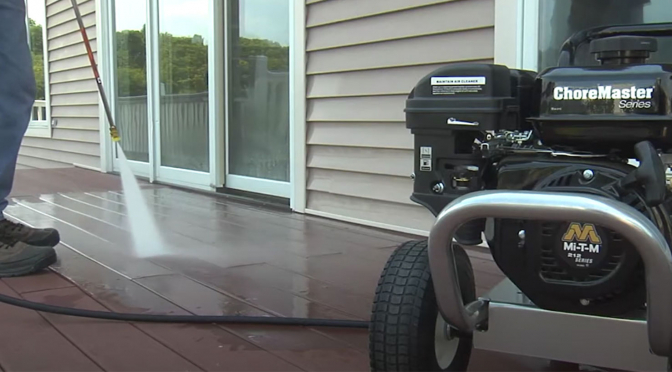An expert with Mi-T-M shares seven tips for stunning results
With rising temperatures, many homeowners will be looking to get their decks ready for summer. In addition to general wear, tear, and traffic, decks are also exposed to harsh outdoor elements. Rain, sun, snow, and ice can wreak havoc on horizontal outdoor wood surfaces—and such exposure requires consistent and proper care. That’s where you and your crew can come to the rescue for homeowners.
Of course, there are a few special considerations to make when dealing with decks. In this article, Don Holdridge—National Paint Division Manager for Mi-T-M—shares seven of his best practices for pressure washing decks.
Choose the right pressure washer. Having great, high-quality equipment will help painters get better results and be more productive on the job site. Holdridge says the Mi-T-M Work Pro 3200 and ChoreMaster 3200 are both “awesome” choices for deck cleaning, since both feature a built-in low pressure detergent injector.
Use the best detergent. Some detergents focus on removing dirt, mildew, and algae stains, while others focus on removing previous layers of stain and sealer. Make sure to choose the detergent that meets your client’s needs. Holdridge recommends the Sherwin-Williams SuperDeck® Deck Care line as “the best product in the business” for deck cleaning.
Protect the surrounding area. Show courtesy for the homeowner’s property. The last thing you want to do if you’re walking onto a homeowner’s property is damage their siding, plants, or objects. Before you begin pressure washing, take stock of the area near the deck and check for anything that could be damaged.
Clean the deck before pressure washing. Holdridge says the number one problem painters encounter with decks is not prepping them correctly: “The deck has to be cleaned before you put any stain down on it. That is a must. Otherwise, the stain will peel, and you may need to endure a costly callback.” Peeling is typically a result of the stain not bonding to the wood due to poor prep leaving dust and dirt on the deck.
Determine the right PSI. Painters need to consider the condition of the deck when setting the PSI for their pressure washer. The higher the PSI, the more pressure at the point where the water meets the wood. If the pressure is too high, it can damage the wood and leave marks. Holdridge generally recommends “anywhere from 2000 to 3000 PSI,” with decks that are older or more splintered set closer to 2000 PSI.
Choose the right nozzle. Holdridge says a 15- or 25-degree nozzle will generally offer the best results; they’re focused enough to provide enough pressure for pressure washing, but without causing destruction to the deck. He cautions against ever using a 0-degree nozzle on a deck job: “A 0-degree nozzle is a fine pencil point, and that would tear the wood up.”
Let the deck dry thoroughly. Another common mistake painters make is failing to let the deck dry thoroughly after it’s washed. Most decks will need 24 to 48 hours to properly dry. If the deck is not fully dry, stains will not adhere properly, requiring callbacks later.
Following these seven tips will ensure that your crew doesn’t damage the deck, avoids callbacks, and delivers homeowners an outstanding result for their deck.

